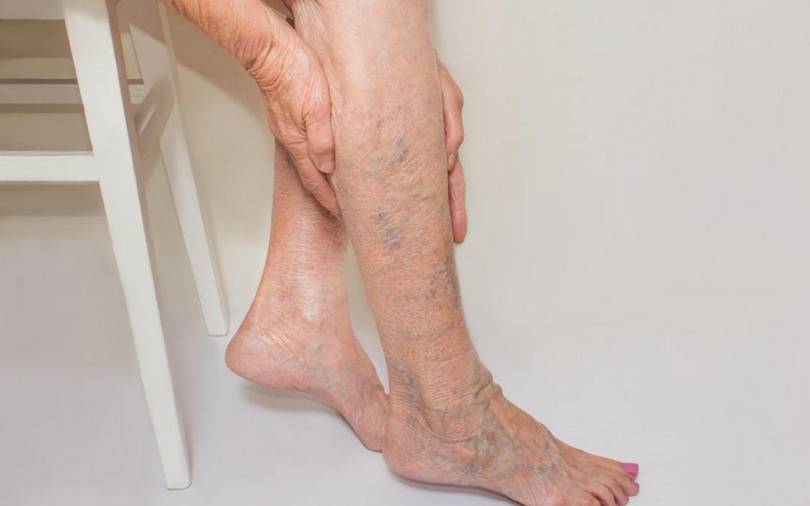Symptoms of vascular disease
Symptoms of peripheral vascular disease are muscle cramps and tightness during walking for certain distances. The cramps disappear once you stop walking for a certain period. There can also be hair loss from the leg and discoloration of the feet in red, blue or black and may be accompanied by pain in the fingers throughout the night, which may Prevents the patient from sleeping and another symptom of vascular disease is gangrene and death of peripheral tissues or ulcers in the limbs.


Causes of diabetic foot:
There are many causes that may lead to diabetic foot, including peripheral neuritis, which leads to loss of feeling in the extremities. Also, diabetic foot may be caused largely as a complication of diabetes or infection that led to atrophy of the tissues of the foot. Diabetic foot disease is one of the most The injuries suffered by the patient are painful and are classified into two types, one of which is the result of infections of the skin surface, or ulcers resulting from the roughness of the skin of the feet or ulcers as a result of neuritis, while the second type of diabetic foot is the result of arterial insufficiency in the foot, a complication of diabetes is the diabetic foot. Which may lead to neglect in treatment to amputation of the leg or foot.
In cases of increased infection or blockage of the peripheral arteries, the doctor may resort to the process of wiping the peripheral blood vessels through the therapeutic catheter or the process of installing stents to maintain blood flow to the feet
When is surgery needed?
Doctors resort to surgical intervention to treat swollen diabetic feet in advanced cases, which are also in degrees. Surgical intervention can be limited only to removing dead tissue to prevent the infection from worsening, in cases of the spread of abscess, infections and dead tissue in the foot. In cases of the beginning of the spread of ulcers and the inability to control patients with diabetes, through surgical interventions to treat peripheral arteries and blood vessels, doctors can resort to amputation of the foot, which is also according to the affected area. The foot and the middle part of the foot to treat the swollen diabetic foot with limited amputation, and it may be the entire foot in case the infection spreads in it to prevent gangrene from occurring in the legs and body.

Varicose surgery:
You know it is a surgical operation in which the damaged veins are removed from the leg, which causes severe and persistent pain in the legs when walking or standing for long periods, or internal bleeding occurs in the veins, which can lead to clots.
The surgery is done by two different techniques, the first is for the doctor to tie the veins causing the varicose veins, and the second option is to remove a specific long strip of the veins causing the varicose veins.
But the surgical technique is not suitable for all people, as those who suffer from some chronic diseases such as heart disease or high pressure often do not have the surgery to remove varicose veins, and the treating doctor can determine the appropriate technique for them.
In most cases, the operation requires general anesthesia to be performed, but you can ask your treating doctor to determine the possibility of having a semi-anesthesia if you want, and you must stay in the hospital for a day or two to check on your condition before returning home.
Many suffer from the appearance of varicose veins, which are swollen and twisted veins, which appear on the surface of the skin of the legs in a blue or dark purple color as a result of a defect in the venous valves, and they are treated by injecting varicose veins, which is one of the medical options and procedures that directly inject the veins With a saline solution, it treats those enlarged veins and treats them without resorting to varicose vein surgery, after injecting the varicose veins, which takes about 10 minutes, the patient can use a medical syrup pressing on the leg that was treated, and then the patient needs several sessions to get rid of the varicose veins permanently.
The surgery is done by two different techniques, the first is for the doctor to tie the veins causing the varicose veins, and the second option is to remove a specific long strip of the veins causing the varicose veins.
But the surgical technique is not suitable for all people, as those who suffer from some chronic diseases such as heart disease or high pressure often do not have the surgery to remove varicose veins, and the treating doctor can determine the appropriate technique for them.
In most cases, the operation requires general anesthesia to be performed, but you can ask your treating doctor to determine the possibility of having a semi-anesthesia if you want, and you must stay in the hospital for a day or two to check on your condition before returning home.
Many suffer from the appearance of varicose veins, which are swollen and twisted veins, which appear on the surface of the skin of the legs in a blue or dark purple color as a result of a defect in the venous valves, and they are treated by injecting varicose veins, which is one of the medical options and procedures that directly inject the veins With a saline solution, it treats those enlarged veins and treats them without resorting to varicose vein surgery, after injecting the varicose veins, which takes about 10 minutes, the patient can use a medical syrup pressing on the leg that was treated, and then the patient needs several sessions to get rid of the varicose veins permanently.
